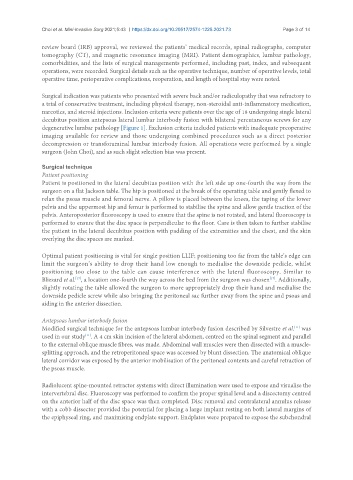Page 437 - Read Online
P. 437
Choi et al. Mini-invasive Surg 2021;5:43 https://dx.doi.org/10.20517/2574-1225.2021.73 Page 3 of 14
review board (IRB) approval, we reviewed the patients’ medical records, spinal radiographs, computer
tomography (CT), and magnetic resonance imaging (MRI). Patient demographics, lumbar pathology,
comorbidities, and the lists of surgical managements performed, including past, index, and subsequent
operations, were recorded. Surgical details such as the operative technique, number of operative levels, total
operative time, perioperative complications, reoperation, and length of hospital stay were noted.
Surgical indication was patients who presented with severe back and/or radiculopathy that was refractory to
a trial of conservative treatment, including physical therapy, non-steroidal anti-inflammatory medication,
narcotics, and steroid injections. Inclusion criteria were patients over the age of 18 undergoing single lateral
decubitus position antepsoas lateral lumbar interbody fusion with bilateral percutaneous screws for any
degenerative lumbar pathology [Figure 1]. Exclusion criteria included patients with inadequate preoperative
imaging available for review and those undergoing combined procedures such as a direct posterior
decompression or transforaminal lumbar interbody fusion. All operations were performed by a single
surgeon (John Choi), and as such slight selection bias was present.
Surgical technique
Patient positioning
Patient is positioned in the lateral decubitus position with the left side up one-fourth the way from the
surgeon on a flat Jackson table. The hip is positioned at the break of the operating table and gently flexed to
relax the psoas muscle and femoral nerve. A pillow is placed between the knees, the taping of the lower
pelvis and the uppermost hip and femur is performed to stabilise the spine and allow gentle traction of the
pelvis. Anteroposterior fluoroscopy is used to ensure that the spine is not rotated, and lateral fluoroscopy is
performed to ensure that the disc space is perpendicular to the floor. Care is then taken to further stabilise
the patient in the lateral decubitus position with padding of the extremities and the chest, and the skin
overlying the disc spaces are marked.
Optimal patient positioning is vital for single position LLIF; positioning too far from the table’s edge can
limit the surgeon’s ability to drop their hand low enough to medialise the downside pedicle, whilst
positioning too close to the table can cause interference with the lateral fluoroscopy. Similar to
Blizzard et al. , a location one-fourth the way across the bed from the surgeon was chosen . Additionally,
[17]
[17]
slightly rotating the table allowed the surgeon to more appropriately drop their hand and medialise the
downside pedicle screw while also bringing the peritoneal sac further away from the spine and psoas and
aiding in the anterior dissection.
Antepsoas lumbar interbody fusion
Modified surgical technique for the antepsoas lumbar interbody fusion described by Silvestre et al. was
[11]
used in our study . A 4 cm skin incision of the lateral abdomen, centred on the spinal segment and parallel
[11]
to the external oblique muscle fibres, was made. Abdominal wall muscles were then dissected with a muscle-
splitting approach, and the retroperitoneal space was accessed by blunt dissection. The anatomical oblique
lateral corridor was exposed by the anterior mobilisation of the peritoneal contents and careful retraction of
the psoas muscle.
Radiolucent spine-mounted retractor systems with direct illumination were used to expose and visualise the
intervertebral disc. Fluoroscopy was performed to confirm the proper spinal level and a discectomy centred
on the anterior half of the disc space was then completed. Disc removal and contralateral annulus release
with a cobb dissector provided the potential for placing a large implant resting on both lateral margins of
the epiphyseal ring, and maximising endplate support. Endplates were prepared to expose the subchondral

